Rupert Parker reports back from the Kurent Festival in Ptuj.. A n historic Slovenian carnival
Huge shaggy horned giants, wielding clubs are chasing me down the cobbled street. The noise from the huge cowbells hung from chains around their waist is deafening. They follow me through squares lined by medieval houses, monasteries and churches. This is the Kurentovanje, the Slovenian equivalent of Mardi Gras, and one of the world’s top ten carnivals.
Its origins lie back in Celtic times and it’s designed to scare off evil spirits, drive out the winter and hustle in the spring. In 2017, UNESCO inscribed it on their list of Intangible Cultural Heritage of Humanity
It’s certainly feeling like winter when I arrive at Ljubljana airport, the landscape covered in a thick layer of snow, and the temperature glacial. I travel 150km east to the town of Ptuj, the oldest settlement in Slovenia, on the banks of the River Drava, dominated by its medieval castle. In Roman times it had a population of over 40,000, twice what is now, but it gradually diminished during centuries of Hapsburg rule.
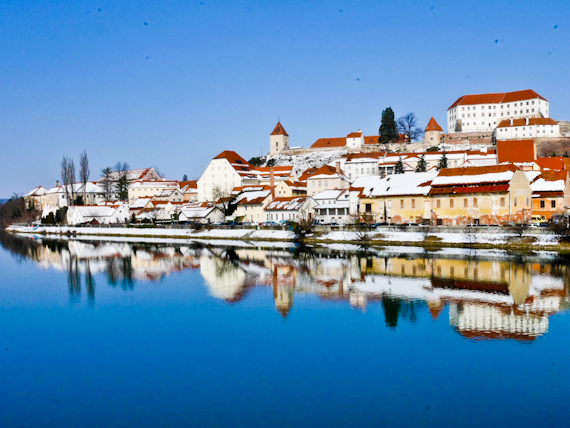
The Kurentovanje also fell out of favour but was revived in 1960 in an attempt to keep the traditions alive. It certainly worked and now the event spans the ten days before Shrove Tuesday and attracts many thousands of visitors. Sunday afternoon sees the International Carnival Parade which involves more than 2500 participants and I take my place in front of the ornate town hall, where a band is playing Slovenian folk music. VIP’s sitting in the stand include the Slovenian Prime Minister.
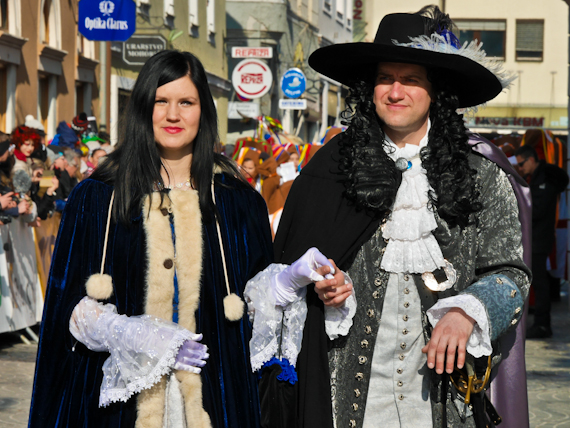
We wait patiently as the procession approaches. It’s led by the prince of the carnival with his princess, surrounded by guards dressed in 17th-century blue and grey. Behind them is a marching band in crusader costumes, mainly young girls. Next comes a group of men in red tunics, blue aprons and black hats, decorated with flowers. They pause in front of the town hall and their guards crack their whips, frightening the crowd.
Following them are tractors full of smoking gypsies, foresters hauling logs, spearmen tossing their ribbon covered spears in the air and a troupe of pantomime horses, known as Rusa. Each is operated by two men and create a bit of stir by spraying the prime minister with water, much to the disquiet of his bodyguards. Still, this is carnival and there’s nothing they can do about it.
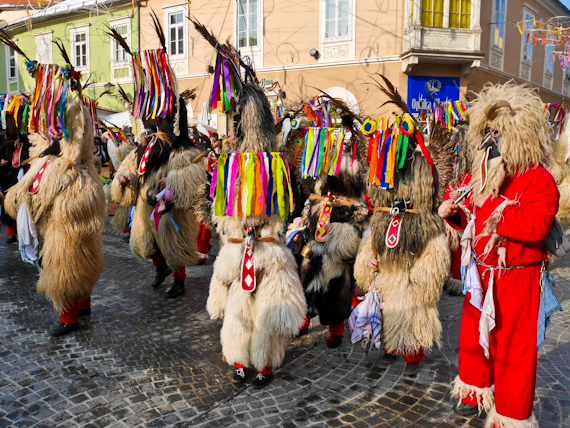
What we’ve come to see are the Kurenti and suddenly there are hundreds of them, lopsidedly twirling, like spinning tops gone wrong. Each Kurent has a coat of shaggy sheepskins, topped with an ornate mask, and wears five large cowbells around his waist. Ears are made of bird wings, adorned with ribbons, the nose is elongated and the moustache is made of maize.
White beans, threaded on a string, serve as teeth and a long red tongue of red cloth or leather spills down the front. Heavy boots and red or green leggings complete the ensemble and they brandish a long stave, studded with hedgehog spikes, to drive the devil forward. Each group of Kurents has at least one of these, standing out in their bright red costume.
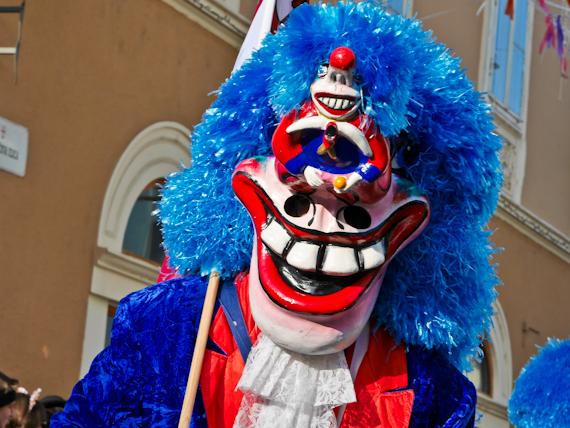
As they dance, the cowbells make an enormous din, momentarily silenced as they pause and form a circle, expanding and contracting. Some Kurents break off and approach the crowd, begging young girls for handkerchiefs to be added to their clubs. You certainly don’t want to mess with them as the masks turn them into shaggy giants and they’re certainly a force to be reckoned with.
After the Kurents have passed it’s the turn of the international troupes. Macedonia has the Meckari, the Czech Republic brings Mystique, France has the intriguing Mülhüser Waggis and the Sitnan are from Slovakia, without forgetting Rain Dance from Macedonia. Serbia has the Cheerful Ice-creams, the Happy Blossoms and Bullfighters and Belgium brings the Sangliers d’Arlon, all dressed in boar skins.
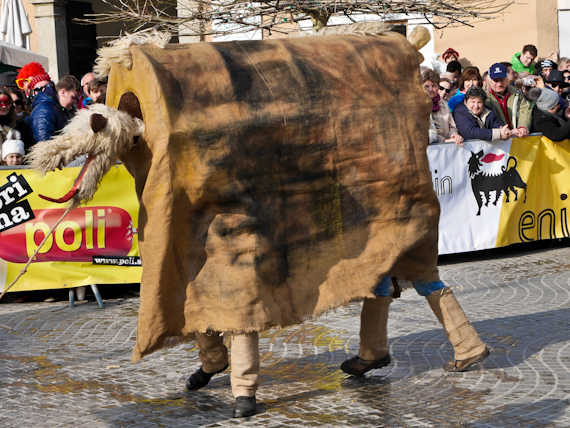
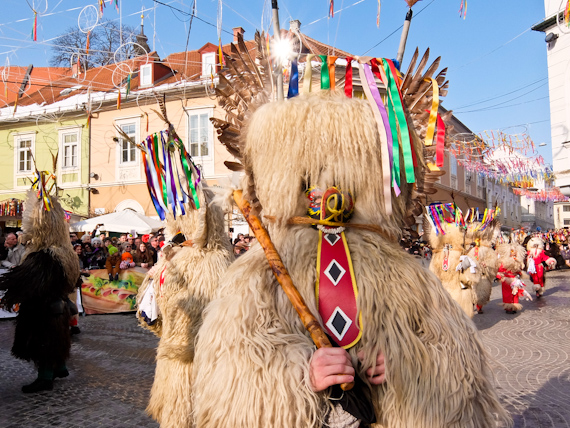
Apparently, the greatest disgrace for Kurents is to be seen without their masks but, outside the taverns, their heads are bare so they can drink. I join them and they tell me that each shaggy coat is made from as many as ten sheepskins, weighs 40 kg and costs over €1000. They show me their masks and tell me that people from the town of Markovci wear bird feathers while those from Haloze have horns. Their purpose is the same – to drive away winter. Later that evening it starts to snow heavily. The devil obviously hasn’t got the message.
Tell Me More About the Kurent Festival in Ptuj.
Kurentovanje has information about the carnival and the next one will take place in 2018.
Ptuj has information about the town.
I feel Slovenia has information about the country.
Wizz Air flies direct from London Luton to Ljubljana
The Grand Hotel Primus in Ptuj makes a good base and has thermal b

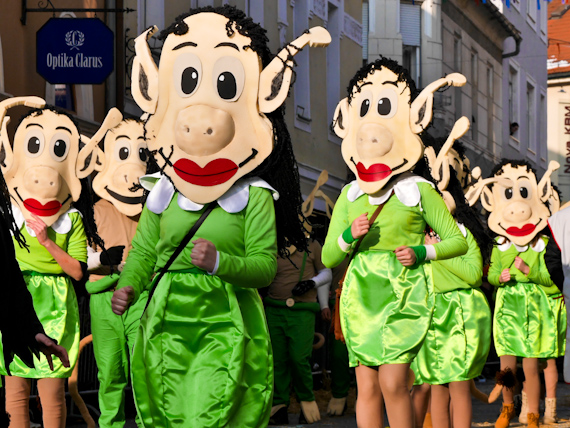

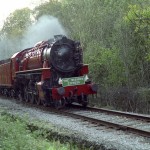
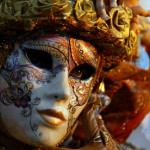
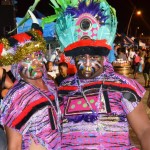

This looks fabulous and thoroughly fascinating! I’d love to photograph it all one day. I particularly love Rupert’s intro. I wonder if they caught? He obviously lived to tell the tale.